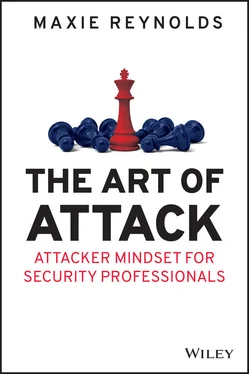The Offensive Attacker Mindset
The offensive attacker mindset (OAMs) allows you as an EA to direct an event in the direction of the objective. More specifically, it allows you insights normally invisible to others (namely defense). It is always scanning for vulnerabilities and creating them from information. OAMs is oppositional and unyielding, and it uses information and environments only to further your position. It does not care about anything outside of its focus, which is always the objective. Typically, your objective as a pentester is access to an asset, information, or place within a building(s) or on a network.
This mindset uncovers a catalog of valuables and vulnerabilities, and not only those you've identified for your own, relatively narrow objective—it also helps you identify what else the target deems important in the moment. It will reveal vulnerabilities that you might not be able to use due to your scope of work or that you've missed because they do not suit your objective but may still be a critical or severe vulnerability. For example, if your objective is to get into the building and to the network operations center (NOC) without using any other entrances or exits other than the front door, you should still note if there are opportunities to do so, whether it be the loading dock or parking structure.
In another example, you may believe due to your scope and objective that the NOC is the thing the company wants to protect most. However, upon entering an environment, you may figure out that actually they are preparing for a market-disrupting move that executives are meeting for, talking about, and writing about. This is valuable information—it doesn't change your scope or objective, but it is worth noting in your report or directly to your point of contact (POC).
OAMs is also what keeps you in a sort of hunt mode as the attack unfolds, identifying any opportunities that present themselves and exploiting them with seeming ease and poise—all without letting the target know that you have any ulterior motive or missing a beat as you deviate from your original plan. It leads you to learn new things about your target and apply those lessons for the good of the objective. For example, you might not learn until you get on-site that they have upgraded their visitor system to a digital kiosk that can be circumvented with the standard out-of-the-box key code.
There is also a sense of competitiveness with OAMs. It doesn't want to be beaten. Ever. It doesn't want to be merciful or helpful. It wants only to win. Your competitive drive is always influenced greatly by your determination to set and achieve goals. It should keep you striving for progress with a quiet but unrelenting focus. It's the peak of your curiosity and persistence combined. It is your competitive desire combined with critical thought that helps you match and surpass defenses meant to stop you. Your OAMs is powerful—a force to be reckoned with, neatly hidden behind a pretext or stealthy moves.
OAMs also guides the achievement of our objective through certain advantageous vectors. It does so by revealing facilitation in places you might not have considered looking otherwise, like vendors, suppliers, insurance providers, and building maintenance contractors. It helps you look at the world in an adversarial and alternative way. It sees through a lens that only identifies helpful or unhelpful data and information. OAMs wants to proceed and succeed. It's the machine that weaponizes information.
My position is this: comfort with risk is one of the most essential offensive skills. Comfort with risk does not equal discomfort with caution, however. Too much discomfort with caution will not serve you in this field.
If you are going out on a mission (say to an armed facility), the risk is in going; you should remain cautious at every step, but, again, too much overt caution in the moment will have you stand out…a surefire way to get shot (no pun intended). For the rest of the operations and engagements you go on, you will need to be comfortable with risk; too much caution in the moment will equate to too little confidence, and this may result in you seeming unnatural, which is the antitheses of your role most often. There are of course times where you will be nervous; my advice is that, in such moments, use those nerves as part of your pretext. Let your nervous energy come out as you tell security that you are running late for a critical meeting.
This position on caution remains valid no matter the vector you are using—being too cautious on a vishing call where the target expects authenticity will likely lower your probability of success. Being cautious with a phish is a thing—it will show up in the length of the email you send. You will likely try to answer every question you can possibly come up with from the target's perspective in the body of your phish—a big no-no. Phishes are to be succinct and not say quite enough, piquing the target's curiosity or piquing some other mood or reaction so that they click on the phish's link. Too much caution on a network pen test will likely prevent you from seeing gaps and exploiting them. You need to be able to take calculated risks.
It's notable that there's a difference between being comfortable with risk and failing to analyze a situation, but OAMs has you strike a balance between the two. The balance can be found in seeking a solution as a problem comes into view. The slight caution that OAMs affords you is what aids the swift identification of a problem. Implementing the solution is a function of comfort with risk. Being comfortable with risk doesn't mean you avoid a problem or deny it exists altogether—it just means that you can be comfortable finding another avenue that isn't your first choice or that puts you at greater risk.
The way to reach something that resembles equilibrium between caution and risk-taking is to apply it with another component of AMs—visualizing outcomes. By further playing that game of mental chess, you should be able to think through the risk factors of the operation. Every move you make comes with a risk, and some risks are the unintended consequences of simply executing an attack. If you try to think about every single measure of risk involved, step-by-step, you will walk straight into failure. But keeping your end goal in mind and thinking through how your next move may impact how you achieve that goal is a good start. It will keep you balanced and on track. Keep a holistic assessment of the risk running in your mind.
To sum up, when executing the attack, you should not be overly or overtly cautious. There has to be a sense of comfort with risk when executing. There is, however, lots of room for caution preceding the execution, which, as you'll see, your DAMs will take care of. The biggest issue of discomfort with risk when executing an attack is that it can reveal you as an intruder. OAMs allows you to maintain a relaxed approach and to act without showing hesitation and avoid the dangers of overthinking.
Planning Pressure and Mental Agility
One of your greatest advantages as an EA is that you know you are attacking, whereas the target is typically oblivious. Often this advantage translates to the illusion of control—the tendency for all of us to overestimate our ability to dominate and manage events. Strictly speaking, you do not have control over the outcome of any operation; it's down to randomness or “luck.” You can do things, however, to steer the outcome in your favor. The initial reveal here is that an abundance of caution will hamper this ability to steer, whereas a relaxed, but risk-aware, approach will function and perform far more highly. This may seem difficult given that, as an attacker, you need to maintain extremely strong offensive mental agility.
Читать дальше












